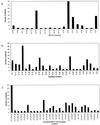Usefulness of spoligotyping To discriminate IS6110 low-copy-number Mycobacterium tuberculosis complex strains cultured in Denmark
- PMID: 10405409
- PMCID: PMC85294
- DOI: 10.1128/JCM.37.8.2602-2606.1999
Usefulness of spoligotyping To discriminate IS6110 low-copy-number Mycobacterium tuberculosis complex strains cultured in Denmark
Abstract
Mycobacterium tuberculosis complex strains cultured in Denmark have been analyzed by IS6110 restriction fragment length polymorphism (RFLP) on a routine basis from 1992 and onwards. Due to the influx of immigrants with tuberculosis, the number of strains harboring only one to five copies of IS6110 has increased steadily. Since the discriminatory power of IS6110 fingerprinting for such strains is poor, we have performed additional genotyping of all low-copy-number strains by the recently described PCR-based method known as spoligotyping. A total of 311 clinical strains were typed: 14 Mycobacterium bovis BCG, 48 M. bovis, and 249 M. tuberculosis strains. Spoligotyping correctly differentiated M. bovis and M. bovis BCG from M. tuberculosis strains, but it did not differentiate M. bovis from M. bovis BCG. All M. bovis BCG strains exhibited identical spoligotype patterns. The discriminatory power of spoligotyping of low-copy-number M. tuberculosis strains was higher than that of IS6110 fingerprinting. Based on RFLP typing solely, 83% of the low-copy-number M. tuberculosis strains were found to form part of a cluster, and 75% were found to form a cluster on the basis of spoligotyping. When the two techniques were combined, the amount of clustering decreased to 55%. The combination of these two techniques might be valuable in studying the epidemiology of M. tuberculosis strains harboring few copies of the IS6110 element.
Figures


References
-
- Alland D, Kalkut G E, Moss A R, McAdam R A, Hahn J A, Bosworth W, Drucker E, Bloom B R. Transmission of tuberculosis in New York City, an analysis by DNA fingerprinting and conventional epidemiologic methods. N Engl J Med. 1994;330:1710–1716. - PubMed
-
- Aranaz A, Liébana E, Mateos A, Dominguez L, Vidal D, Domingo M, Gonzolez O, Rodriguez-Ferri E F, Bunschoten A E, van Embden J D A, Cousins D. Spacer oligonucleotide typing of Mycobacterium bovis strains from cattle and other animals: a tool for studying epidemiology of tuberculosis. J Clin Microbiol. 1996;34:2734–2740. - PMC - PubMed
-
- Burman W J, Reves R R, Hawkes A P, Rietmeijer C A, Yang Z, el Hajj H, Bates J H, Cave M D. DNA fingerprinting with two probes decreases clustering of Mycobacterium tuberculosis. Am J Respir Crit Care Med. 1997;155:1140–1146. - PubMed
MeSH terms
Substances
LinkOut - more resources
Full Text Sources
Other Literature Sources
Medical

